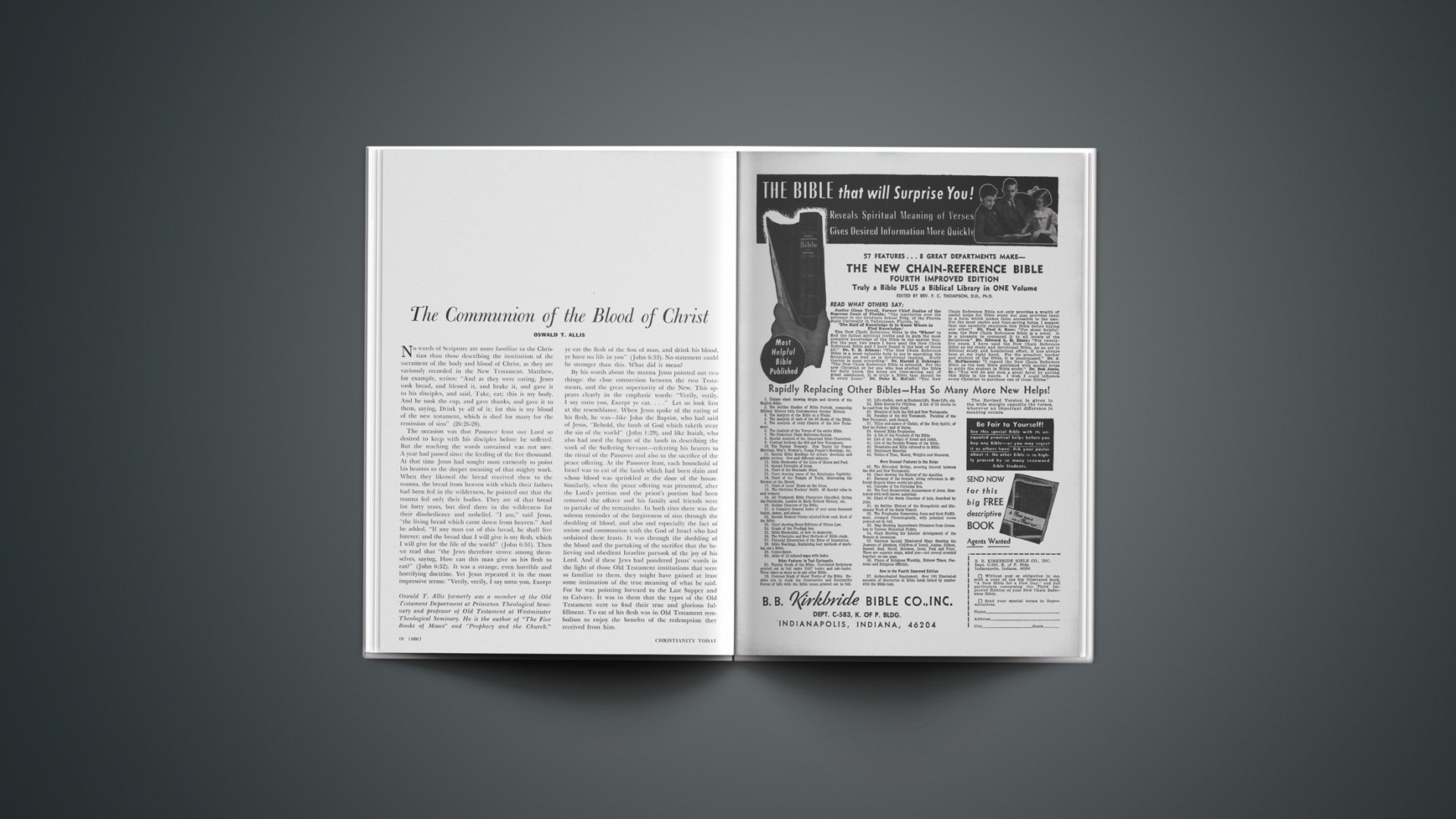The horizon is the apparent junction of land and sky. It is the place at any given point of the earth beyond which the human eye cannot see. As one ascends in the air the distance to the horizon increases, but the horizon is always there. Even in the amazing new photographs relayed from our satellites, photographs that include both the South and North Poles, the horizon is visible.
Generally human vision extends in a straight line; man’s eye, unaided, cannot look around a corner. Light is radiated in straight lines. It is diffused according to the geometrical laws of reflection, and man’s vision is limited by these same laws.
Scientists have developed an amazing process by which they can bend light so that it can be transmitted around curves or corners as desired. Called “laser” or “maser,” these light waves are used to activate the molecules in crystals, such as rubies, so that they remain in almost parallel lines and can be beamed in circles or in other ways.
The writer has seen the utilization of this new form of light in diagnostic instruments in which the cold, clear light beamed into one end of a cable came out the other end, even though the cable was tied in several knots. The potential uses of laser in the medical field seem almost unlimited: for diagnosis, the treatment of localized cancer, the welding back of detached retinas, and other uses yet to be perfected.
Because they are parallel, controlled laser rays can be sent to the moon and then diffused over the moon’s surface for an area no more than half a mile wide. Radio and television broadcasts can also be transmitted over laser beams. And the “death ray,” so often described in science fiction, is inherent in this new discovery and is a potentially destructive weapon for use in warfare.
The writer is neither capable nor desirous of making this page a place for scientific discussion, but in laser there are analogies to spiritual things that merit our consideration.
Through the ages man has been able to see beyond the horizon of human existence, on into eternity. Today, however, humanistic and existential philosophies are so clouding our vision that we need to reorient ourselves to the possibilities that are ours because of the divine revelation.
Jesus Christ is the divine laser—the Light that is able to shine into hearts and minds in this present life and give vision on beyond the horizon into eternity. This ability is claimed for him in the familiar words, “In him was life, and the life was the light of men. The light shines in the darkness, and the darkness has not overcome it” (John 1:4, 5, RSV). Our Lord himself said: “I am the light of the world: he who follows me will not walk in darkness, but will have the light of life” (John 8:12).
Jesus can bring immediate light into blinded hearts and minds. This spiritual light—the divine laser—means 20/20 spiritual vision such as that given to Moses, of whom we read: “He endured as seeing him who is invisible” (Heb. 11:27b).
This world’s greatest problem is spiritual blindness, a darkness so total that nothing less than Christ himself can penetrate its recesses and bring light. One of the most spectacular types of surgery is that for cataract. One moment the patient cannot see; the next he can distinguish and describe objects. In the spiritual realm the transformation of a sin-blinded soul into one who sees and identifies the Light is a work of the Holy Spirit.
Paul speaks of the experience of the Jews in this way: “But their minds were hardened; for to this day, when they read the old covenant, that same veil remains unlifted, because only through Christ is it taken away.… But when a man turns to the Lord the veil is removed” (2 Cor. 3:14, 16).
Today the world desperately needs to know and believe in the divine laser: “And even if our gospel is veiled, it is veiled only to those who are perishing. In their case the god of this world has blinded the minds of the unbelievers, to keep them from seeing the light of the gospel of the glory of Christ, who is the likeness of God” (2 Cor. 4:3, 4).
It is the Gospel that enables man to see time and eternity in their proper perspective: “We look not to the things that are seen but to the things that are unseen; for the things that are seen are transient, but the things that are unseen are eternal” (2 Cor. 4:18).
In Second Kings we read the story of Elisha surrounded by the Syrian host at Dothan. The young man with him saw the enemy and was terrified. But Elisha saw more. He prayed, and the young man was then able to see the mountain “full of horses and chariots of fire round about Elisha.”
How prone we are to see Satan’s hosts and work and to fail to realize that God’s presence and power are real and greater than all who would oppose him. Nowhere can we sense the reality of spiritual insight more than in chapter eleven of Hebrews. Of these heroes of faith we read: “These all died in faith, not having received what was promised, but having seen it and greeted it from afar …” (v. 13). Simeon had this same Spirit-derived vision when he prayed: “Lord, now lettest thou thy servant depart in peace, according to thy word; for mine eyes have seen thy salvation” (Luke 2:29, 30).
To the Church has been given the glorious task of preaching the Gospel, which brings light and understanding to those willing to believe. Surely Satan must chortle when he sees so many shifting their interest to purely secular and material concerns! This neglecting of the eternal emphasis of the Cross and resurrection of Christ adds to the darkness and confusion of an already blinded world.
Without Christ, man’s vision is limited to this world. Without him men are spiritually blind, unable to see or understand the things that have to do with eternity.
The Church has a glorious message if only she will preach it. Men are living in a dying world and need the message of salvation beyond the grave. As J. B. Phillips so aptly translates Hebrews 6:18: “So that … we who are refugees from this dying world might have a source of strength, and might grasp the hope that he holds out to us.”
This “hope” centers in the “anchor for our souls, fixed in the very certainty of God himself in Heaven” (Heb. 6:19, Phillips), and it is the message which needs to be shouted from the housetops.
Christians need to be reminded that “here we have no lasting city, but we seek the city which is to come” (Heb. 13:14). And Christians should remind those who do not know Christ that by him and him alone can they see beyond the grave into that glorious eternity that he has prepared for all those who love him.
The teaching of the Bible about the Holy Spirit is found not only in the New Testament but also in the Old Testament. The second verse of the Bible speaks of the Spirit of God as active at the beginning. “The Spirit of God,” that verse says, “moved upon the face of the waters.” We think also, of course, of the work of the Spirit in empowering the prophets when they came forward with a message from God. In some places the Spirit appears as the giver of some special qualification; the Spirit also appears as determining a holy life.
In the New Testament books that clear teaching is certainly present. At first sight, indeed, it might not seem to be so abundant as we might expect it to be. The deity of the Holy Spirit is everywhere perfectly plain, but the distinct personality of the Holy Spirit does not seem to lie so clearly on the surface. Hence it is not surprising that in discussions of the doctrine of the Holy Spirit the question that is chiefly discussed is different from the question that is discussed with regard to Christ.
With regard to Christ, the distinct personality of the One who is presented is everywhere perfectly clear, and therefore argument is quite unnecessary about that. The question that needs discussion about Christ is the deity of the One spoken of. Christ appears to a superficial observer not as God but as a man. What needs to be done is to show that he is both God and man.
But with regard to the Holy Spirit it is just the other way around. The deity of the Holy Spirit is everywhere perfectly clear; but what seems at first sight paradoxical, what seems to require discussion, is the true personality of the Spirit. It is clear that the Spirit of God is God; but it might seem at first sight very strange that the Spirit of God should be a distinct person within the Godhead.
However—strange though that is—the Bible makes perfectly clear that it is true. A careful reading of the Bible shows that the true personality of the Holy Spirit, though not often made the subject of direct exposition, really underlies and gives meaning to everything that the Bible says about the Spirit of God.
For one thing, the great Trinitarian passages in the Bible really imply the personality of the Spirit. When, for example, our Lord in the “Great Commission” at the end of the Gospel according to Matthew commands the apostles to make disciples of all the nations, “baptizing them in the name of the Father, and of the Son, and of the Holy Ghost,” can he possibly mean that although the Father and the Son are persons, the Holy Ghost is a mere impersonal aspect of the being of the Father or of the Son? The perfect coordination of the three—Father, Son, and Holy Ghost—would seem to make such an interpretation extremely unnatural.
But the passage where the personality of the Holy Spirit is most clearly and gloriously set forth is found in the intimate discourses of our Lord with his apostles, as those discourses are recorded in the Gospel according to John. Here our Lord speaks of the Holy Spirit as “another Comforter,” or rather (by what is probably a better translation of the word) “another Advocate.” The Holy Spirit, then, is in one sense “another” as over against Jesus; indeed in John 16:7 Jesus says that his, Jesus’, departure means the Spirit’s coming. “It is expedient for you that I go away; for if I go not away, the Comforter will not come unto you; but if I depart, I will send him unto you.”
The Holy Spirit appears very clearly in this precious passage as a true person. He proceeds from the Father and the Son, not as a mere emanation or a mere force, but as a person who stands in a truly personal relationship with the two other persons in the Godhead. Again and again in this wonderful passage the personal relationship between all three persons of the Trinity is set forth. In one verse at least, our Lord uses the first person plural in speaking of himself and God the Father. “If a man love me,” he says, “he will keep my words: and my Father will love him, and we will come unto him, and make our abode with him.” Here Jesus of Nazareth, a man who walked upon this earth, joins himself with God the Father in a fellowship in which one person joins himself with another. “We will come.”
The Bible never allows us to forget the primary truth that there is but one God. That truth is pressed home in the Old Testament, but it is pressed home just as insistently in the New. When the New Testament teaches that Father, Son, and Holy Ghost are three persons, it teaches with equal insistence that these three persons are one God. The New Testament writers never seem to be conscious that one of these two great truths could by any chance be regarded as in contradiction with the other. They are never for one moment conscious of any danger lest when they present the deity and the personality of the Son and of the Spirit they may lead men away from the unity of God. So in the Gospel of John Jesus says, “I and the Father are one”; yet in that same Gospel he says, about the Father and himself, “We will come”; and in that same Gospel he says, “I will pray the Father, and he shall give you another Comforter.” One God, three persons, each person God—so the Bible presents, in majestic harmony, what God has graciously revealed to us of the mysteries of his being.—J.G.M.












